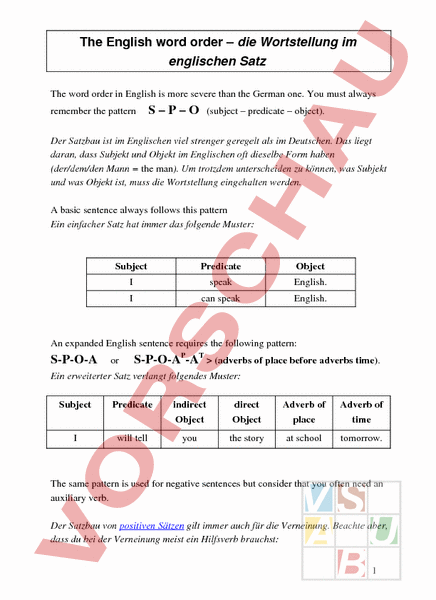Arbeitsblatt: English word order
Material-Details
The English word order - die Wortstellung im englischen Satz: S-P-O > S-P-O-A. A small grammar summary with some examples.
Englisch
Grammatik
8. Schuljahr
3 Seiten
Statistik
38044
1756
50
04.04.2009
Autor/in
Bartolome Tscharner
Land: Schweiz
Registriert vor 2006
Textauszüge aus dem Inhalt:
The English word order – die Wortstellung im englischen Satz The word order in English is more severe than the German one. You must always remember the pattern S–P–O (subject – predicate – object). Der Satzbau ist im Englischen viel strenger geregelt als im Deutschen. Das liegt daran, dass Subjekt und Objekt im Englischen oft dieselbe Form haben (der/dem/den Mann the man). Um trotzdem unterscheiden zu können, was Subjekt und was Objekt ist, muss die Wortstellung eingehalten werden. basic sentence always follows this pattern Ein einfacher Satz hat immer das folgende Muster: Subject Predicate Object speak English. can speak English. An expanded English sentence requires the following pattern: SPOA or SPOAPAT (adverbs of place before adverbs time). Ein erweiterter Satz verlangt folgendes Muster: Subject Predicate indirect Object direct Object Adverb of place Adverb of time will tell you the story at school tomorrow. The same pattern is used for negative sentences but consider that you often need an auxiliary verb. Der Satzbau von positiven Sätzen gilt immer auch für die Verneinung. Beachte aber, dass du bei der Verneinung meist ein Hilfsverb brauchst: 1 Subject Predicate indirect Object direct Object Adverb of place Adverb of time will not tell you the story at school tomorrow. didnt tell you the story at school yesterday. My mother isnt at home now. The word order in subordinate clauses Even in subordinate clauses the word order remains the same: Auch bei Nebensätzen bleibt die Reihenfolge gleich: Main clause (SPO): The the reason Conjunction (linker) Subject Predicate indirect Object why wont tell why told direct Object Adverb of place Adverb of time you the story at school tomorrow you the story at school yesterday is that cant trust you. is that can trust you. The word order with time indication General time indication (now, then, yesterday, today, tomorrow, recently) are usually placed at the end of sentence: Allgemeine Zeitangaben stehen normalerweise am Satzende: Subject Predicate indirect Object direct Object Adverb of time will not tell you the story tomorrow. didnt tell you the story yesterday. 2 But if you want to emphasise the time indication, then you can put it at the beginning of sentence. Aber wird ein zeitlicher Gegensatz betont, dann stellt man die Zeitangabe an den Satzanfang. Adverb of time Subject Predicate will tell indirect Object you direct Object the story. Tomorrow Yesterday told you the story. The word order with adverbs of frequency The adverbs of frequency (always, usually, often, never) always come after the subject or after the auxiliary verb. Die Häufigkeitsadverbien und stehen nach dem Subjekt und nach dem Hilfsverb: Subject Auxiliary verb adverb of frequency Full verb often go swimming He doesnt always play We are usually Object Adverb of time/ Adverb of place in the evenings. tennis on Saturdays. here in summer. The word order with modal adverbs Adverbien der Art und Weise The modal adverbs (e.g. slowly, carefully, awfully) come after the direct object. If there isnt any, they come after the verb. Die Adverbien der Art und Weise stehen hinter dem direkten Objekt. Ist keins da, stehen sie hinter dem Verb. Subject Predicate direct Object Modal adverb 3 He drove the car carefully. He drove carefully. The word order with adverbs of place Adverbien des Ortes The adverbs of place (e.g. here, there, behind, above) come at the end of sentence. Die Ortsaverbien stehen hinter dem direkten Objekt, wenn diese fehlt hinter dem Verb. Subject Predicate Object Modal adverb He stayed behind. didnt see him there. 4
